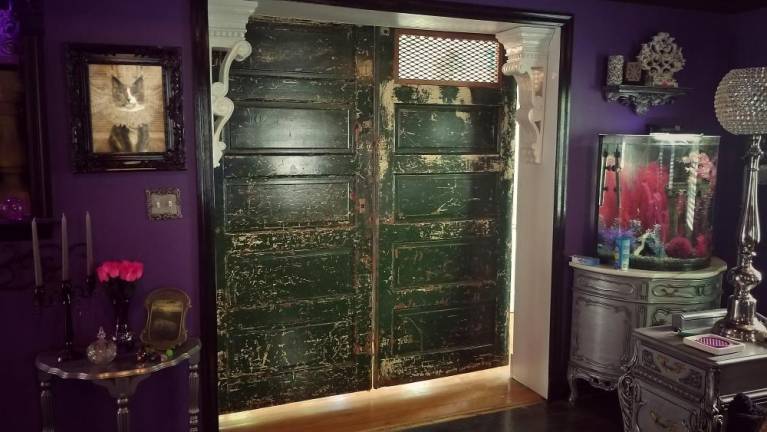If these doors could talk
Dodging the wrecking ball to be installed — in all their sad, peeled beauty — in our den






This quarantine began as a time of great caution, a safeguard against an unknown disease. But for many, including myself, it evolved into a time of introspection. Strange enlightenment. I took time to reflect on my environment. How our homes are in many ways extensions of ourselves, and within those walls, we thrive, fed by the thoughts and inspirations with which we surround ourselves. With that mindset I set forth, finally having the wherewithal to tackle a project years in the making.
First, some backstory. My partner and I do a lot of work advocating architectural preservation. Readers may have noticed this is a reoccurring theme in my column; no coincidence, as it is one of my great life passions. Unfortunately, it also led to one of our greatest heartbreaks in 2015, when the Greystone Park Psychiatric Center in Parsippany, NJ, a building we spent years trying to save, was demolished. That old hospital represented a great many things to a great many people. To us, it meant the loss of a national treasure and a long fight that, though lost, we will never regret fighting. Nationally, Greystone was of significance for not only ending the practice of lobotomies, but for being widely considered the pinnacle of the Kirkbride Plan form of psychiatric treatment when it opened in 1876. Through the lens of modern medicine, the method devised by Dr. Thomas Story Kirkbride may look unrealistic, almost fairytale in its composure. But if you study his texts, you see an underlying philosophy of patient care for the mentally ill that is of the most compassionate ever conceived. In short, he believed that “beauty is therapy.” That your wellbeing is directly shaped by your environment and the positivity it exudes. We know now that one cannot be cured simply by beauty and compassion, but our attempt to try throughout the late 1800s led to some of the most selfless use of state funding on record, and some of the most beautiful buildings ever conceived.
“There is no reason why an individual who has the misfortune to become insane, should, on that account, be deprived of any comfort or even luxury,” Dr. Kirkbride famously said. It is key to keep in mind that this was his method of thinking during a time when those suffering from mental and physical handicaps were quite literally being warehoused away, thought of as subhuman. Kirkbride set about changing this mindset, and through his work, some 70-plus hospitals were built across the country to provide a place for these placeless souls. Not just hospitals though; these facilities were castles, beautiful resorts built to offer help to many who could not even express their thanks. Most are now gone, Greystone included.
As the massive 650,000-square-foot old hospital was bring razed in 2015, we got to know the demolition crew during our frequent visits to document the site. They knew of our love for the building, and in private some of them even lamented their task. During the final days, we were allowed one last walk inside, to see the building a final time and say our farewells. On our way out, one of the crew asked if we would like to have a memento, since it would all be going down with the building that week. We chose two large wooden doors, sad and peeled as they were. The choice surprised the crew, but they removed them and loaded the doors into our truck all the same. The doors went to storage for years. Safe, but kept away.
Back to today: My partner and I have been fixing up an 1850 house in the town of Milford, PA, for years. This pandemic served as the catalyst to finally do something with those old doors. Enough time had passed that we could look at them and not be pained by the terrible loss from years ago, and we wanted them to be around us in our daily lives. It took months of work: scraping, cleaning and lacquering with untold layers. They now adorn our home, of use once again. We chose from the outset to maintain them, as best we could, in the state they were in when removed from the old hospital, frozen in time. They now hang as sliding doors between our living room and the den. No longer sad reminders of a lost fight, they now encourage us every time we look at them, reminding us that we, as a people, can do great things when driven by empathy.